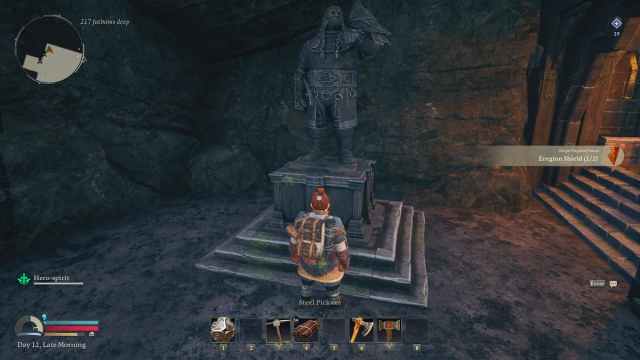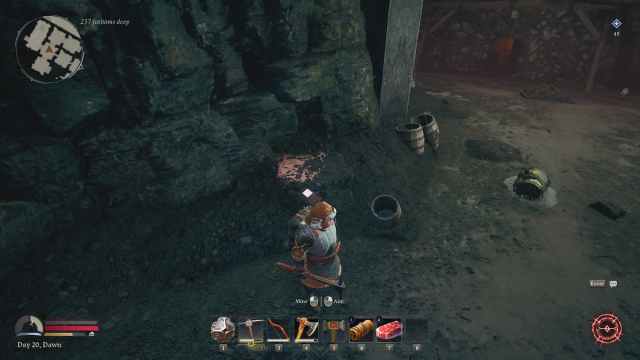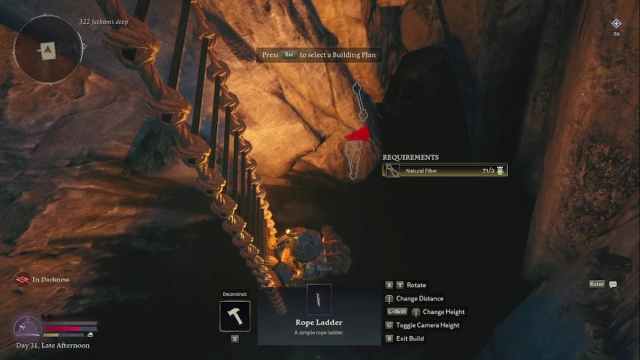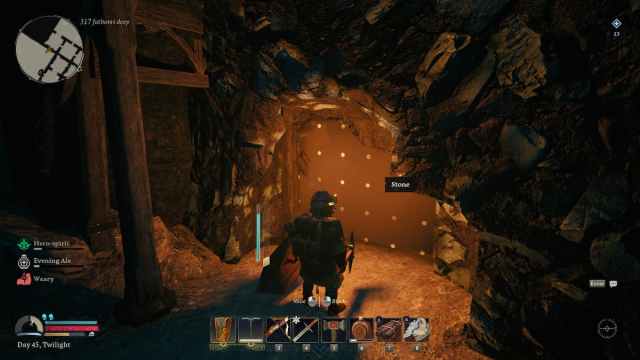Dwarves have been summoned back to Moria during the fourth age of Middle-Earth. Free of the One Ring’s influence and the shadows that clung to its depths, prepare yourself to defeat the remaining orcs and rebuild the empire of Khazad-dum in Lord of the Rings: Return to Moria.
Return to Moria Review: Delve the Depths to Reclaim the Mines
The dwarves have heeded the call of Gimli himself to take back the Black Pit. Though Durin hasn’t reappeared to lead the charge, there’s no better time to cleanse Moria of the shadow that corrupts it. You’re one of these dwarves, ready to face Orc, Goblin, or even the Balrog to reclaim what is rightfully dwarven.
Due to a slight accident during the opening sequence, you end up in the mine along Durin’s Highway. This begins your adventure to find your way to Durin’s Door. Unfortunately, the shadow that once clung to Moria still stands, blocking the doors from opening. You need to mine, fight, sing, and scavenge your way through the mines until you’re free from the ever-present darkness.

Story and Survival
I initially went into the game with little knowledge of what it’d be about, except it was survival and dwarves. Who needs more, really? The actual story of the game, while it wasn’t what drew me in originally, is definitely a strong point.
Along with simply surviving the darkness and defending against everything trying to kill you, you find numerous bits of the story. You learn of Bolin’s company, who’s hunting broken fragments of Durin’s Axe. They left clues behind that you can follow to reclaim these pieces of dwarven heritage. You find runes left by Gandalf, and hobbit plates from the Fellowship of the Ring. There’s so much story everywhere that I wanted to continue playing even when I died about 10 times straight. Those deep, dark pits are no joke.
When it comes to the survival mechanics, it’s similar to others in the genre. You need to sleep to restore energy, you have a stamina bar, you’re required to eat, and you have your overall health. There are a variety of recipes, different crafting pieces to build and enhance what you can make, and diverse resources to collect.

What I really love is the addition of morale along with the level of light you’re in. If you stay in the dark too long, such as scaling down into the depths for rare gems, your morale will disappear quicker than a black diamond stolen by orcs. Once it’s gone, your health drains until you die or find a source of light. Daylight saves lives in Return to Moria.
Another mechanic I like is sound. You’re playing in a mine or a cave. Sound echoes. You can hear it, and so can all the enemies lurking near you. The louder you mine, the more orcs or goblins you draw to you. To keep track, there’s a sound meter on the bottom right of the screen. When it’s red, be quiet. Otherwise, you’ll trigger a hoard of 20 or more enemies converging on your location as well as digging up through the ground if you run. Honestly, I wish they focused on this more often since I make a ton of noise at night but have only triggered one hoard in my 30 hours of playtime, aside from those that are quest-related.

Singing Makes It All Better
True to Dwarven lore, playing through LotR: Return to Moria almost feels like I’m playing a musical. You can sing when mining ore, drinking, and cleansing shadow seeps. Singing grants different buffs depending on the activity, but on the whole, launching into tune is always a good idea. It doesn’t hurt that they’re catchy, either. I’ve even found myself singing along or grooving in my chair while playing.
Solo Experience Versus Multiplayer
I played the game with my world offline and no assistance from friends. While it may seem like I don’t have insights into multiplayer, the absolute stomping you can get solo really highlights how multiple dwarves can mitigate some of the harder aspects of the game.
I’m speaking of the hoards, orc settlements, and sieges. These all have large numbers of enemies, often with armor and potentially accompanied by flying monsters. Trying to deal with all of that at once, in limited light or space, makes survival near impossible. With even one more person playing, the odds are evened. You won’t have to worry about switching between melee and ranged weapons. Additionally, you can run away to heal while they handle things, and you’ll both take down enemies quicker.

Downsides of the Deep
Every game has some downsides. For Return to Moria, that’s the building system and a number of bugs that crop up.
When building, it’s pretty tough to see where you’re placing items, how far into or out of the wall they actually are, and if your dwarf can even reach it to climb up. Many times I’ve placed items 3/4 in the wall because the light level doesn’t change when you enter build mode. If you’re functioning with a torch and need to build a quick platform farther down, you have difficulty seeing what you’re doing.

Along with the difficulties in seeing how to place items, you can’t move them once they’re placed. You must destroy the structure. If this happens to be over a pit or deep water, kiss those resources goodbye. You’ll never get your wood back from the watery depths. You can at least attempt to scale down to pick up your loot that dropped down a pit. But not having the resources automatically go back into your inventory can really mess up your building plans.
Bugs, Bugs, Bugs — And I Don’t Mean the Spiders
While the main functions of the game are pretty solid, several small bugs or glitches dampen the overall feel of the game. When they all repeatedly happen, it can wear you down to the point you don’t want to deal with them.
- General clipping when attempting to climb rock structures.
- Wrong name listed on a farm plot that you’ve previously uprooted a plant from.
- Entrances and openings don’t load properly, forcing you to restart the world to get through.
- Positioning for mining is finicky. Even if the marker is on it, the resource won’t get mined or disappear. You have to back away or move closer for it to work. This also applies to chopping trees or smashing chests. The aiming is off.
- Enemy randomly jumps positioning, causing you to miss or be hit instead of blocking the attack.
- Load times during fast travel get significantly longer the more you use the feature, topping a few minutes.

Spider Alert
Now it’s time for spiders, and there are a lot of them. I only mention this for those who fear the creepy crawlies. You won’t see the eight-legged creatures until you get into the Mines of Moria. But they’re large, typically attack in groups, and can dish out ranged damage. Killing them or harvesting their silk is the only way to obtain Natural Fiber early on, so you have to deal with these critters.
To dispatch them permanently, you need to destroy the giant spider egg towers they defend. Doing so, however, results in masses of baby spiders flying out around the tower to crawl away. You don’t fight these, but they can cause quite a fright. Thankfully, I haven’t come across any Shelob descendants, so giant, hobbit-eating spiders seem not to be included.
Lord of the Rings: Return to Moria Review — The Bottom Line
Pros
- Interesting storyline stemming from the Fellowship of the Ring
- Variety of resources to collect, grow, or craft
- Extensive areas to explore with hours of content available
- Morale and sound mechanics
Cons
- Difficult to use building system
- Long Fast Travel load times
- Bugs that can wear down your enthusiasm
- Inability to move structures once placed
Overall, Return to Moria is a solid entry in the survival genre. It has some unique gameplay mechanics that are fun to explore, while the Middle-Earth setting lets a dedicated fanbase venture into the world in a new way. Aside from bugs that will hopefully be resolved in soon-to-come updates, I can see it being a staple among players. I know it holds a solid spot in my survival rotation.
[Note: Free Range Games provided the PC copy of Lord of the Rings: Return to Moria used for this review]










Published: Oct 28, 2023 04:24 pm